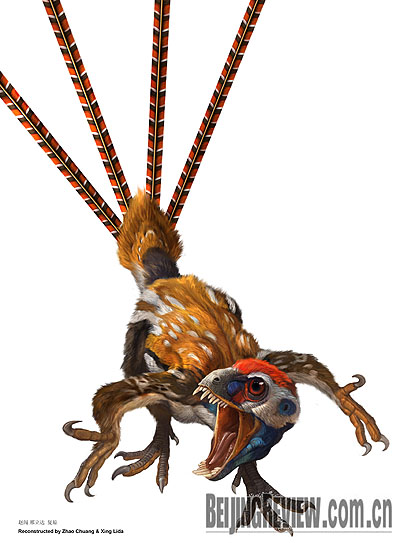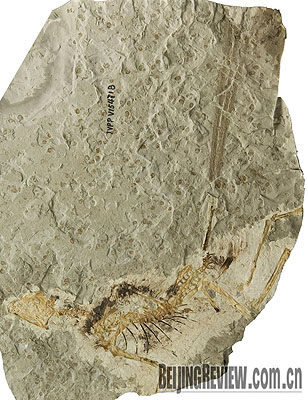| 
MISSING LINK: What the Epidexipteryx hui might have looked like
A newly discovered dinosaur fossil has been on display in the Paleozoological Museum of China since October 25. The fossil of a small maniraptoran dinosaur, named “Epidexipteryx hui,“ was discovered last year by Chinese scientists in Inner Mongolia Autonomous Region. The fossil shed new light on the transition from dinosaur to bird.
 ANCIENT EVIDENCE: The fossil of Epidexipteryx hui, a newly discovered dinosaur species
ANCIENT EVIDENCE: The fossil of Epidexipteryx hui, a newly discovered dinosaur species
Epidexipteryx hui was a bird-like dinosaur that lived in the Middle to Late Jurassic period, which is about 205 million to 144 million years ago. This dinosaur had four long ribbon-like plumes that fanned out from the tip of its tail, which set it apart from any dinosaur discovered earlier.
“Phylogenetic analysis showed that Epidexipteryx hui is an Avialae, a family of dinosaur that is the closest to birds,“ said Zhang Fucheng, a Research Fellow at the Institute of Vertebrate Paleontology and Paleoanthropology. He said that researchers compared its features with that of dinosaurs and birds of 80 species before they could identify Epidexipteryx hui as a new species.
Zhang was one of the discoverers of Epidexipteryx hui. The discovery was documented in a paper titled A Bizarre Jurassic Maniraptoran from China With Elongated Ribbon-like Feathers, published on October 23 in the U.K.-based journal Nature. The paper was written by Zhang and several co-authors including Zhou Zhonghe, Xu Xing, Wang Xiaolin and Corwin Sullivan.
Epidexipteryx is a Latin word that means feather for display. Hui is derived from the name of the Chinese paleontologist Hu Yaoming, who passed away in April at the age of 42 because of liver cancer. Hu was a dedicated scientist who published numerous papers on mammals. To commemorate Hu, his colleagues named their discovery after him.
Filling the age gap
Dinosaurs roamed the Earth for about 160 million to 170 million years before suddenly going extinct in the late Cretaceous Period. During their long existence, dinosaurs evolved and some turned into birds.
| 